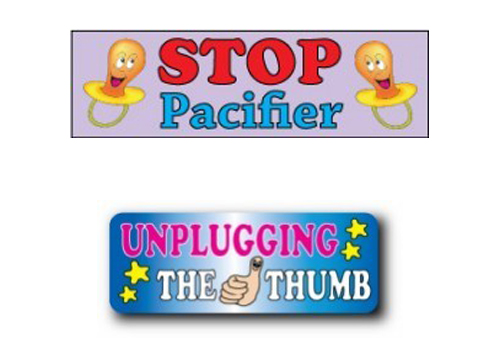
Unplugging the thumb
Unplugging the Thumb (UTT) is an innovative program created by Sandra R. Holtzman, MS, CCC/SLP, COM.
How bad is Thumb sucking for my child?
Although we cannot find a consensus about how bad it is, we know for sure that it is only a matter of time until the thumb sucking becomes a detrimental habit. When a thumb (finger, blanket, knuckle) is inside the mouth, the lips, teeth, tongue and jaw can NOT function properly. They simply cannot work around the intruder. This leads to an undesirable way of swallowing, speaking and even breathing.
Pacifier use is the most common non-nutritive sucking habit. It usually begins when parents introduce it in order to calm their child. Over time, it becomes a form of amusement as well, and the child becomes attached to it. Depending on the intensity, frequency, and duration of the habit, pacifiers may affect dental occlusion. Improvement may occur once the habit is eliminated, depending on the child’s age and other factors.
How do these programs work?
We use audio visual methods that explain the consequences of oral habits and include on-going goals that the child is able to achieve. This helps maintain motivation throughout the program…
They include a Parent Guide with directions and order of presentation, a story about a child who makes the decision to quit, and specific items related to each program. When might you be better off to wait?
• Generally, we suggest waiting if the child is under the age of 4. Although we have had success with children as young as 3, they tended to be kids with strong language comprehension and expressive skills, characteristics that probably contributed to their success because they were able to reason at a higher level than the typical three year old.
• Four year olds or older children who have significant learning, emotional, behavioral, or medical conditions. This could render the program ineffective for them until they are a bit more mature or until the difficulty is remediated sufficiently.
• Anticipated changes on the horizon that will conflict with the child’s or parent’s usual schedule. The arent must choose the right time to start so she/he can be available to share the various “fun aspects of the programs. Is there a recommended upper age limit?
The suggested ages are from 4 – 10 years, but there are many children over the age of 10 years who have benefited. A few minor changes can be made to add to the fun for older children, but the program steps and main objectives remain the same. Why can’t I just use bitter tasting solution on my child’s thumb or finger(s)?
Of course, you can choose to go that route, but I find it unfair and unreasonable to use a punishing or distasteful (for sure distasteful!) method. I feel strongly that a child should be included in decisions that involve his life choices. If the child is the one who decides to quit, the chance of success is
naturally much, much higher. If we want positive change, we should use positive methods. By doing so, we are sending a message much stronger and more important to our child… that he has the ability to make wise choices, work through difficulties, and achieve success he can be proud of!!

Testimonials
My son, Ryan, is a 16 year old who suffers from Autism as well as a syndrome that causes some dysmorphic facial features. Due to structural anomalies Ryan has a hard time closing his mouth, is a mouth breather, drools , has trouble forming certain sounds and his tongue pressing against his teeth is causing his teeth to push outward despite braces. Ann started doing myofacial therapy with Ryan and I cannot believe the change. It is so different from what his Speech therapist is doing. He is better able to control his mouth, his mouth is not hanging open as much and the drooling has decreased drastically. She is very patient with him because he has a hard time with body awareness, which causes us to have to do everything over and over, but I cannot believe the change in him. She is dedicated to helping in ways I didn’t even know possible. No one tells us these services are available. Now that I see what she is able to accomplish, all I can see is the amount of children that would benefit from her services. Not only is she a therapist, but a teacher as well. She patiently explains everything to me so that I can continue to work with Ryan at home. I am excited to see all the improvements that are yet to come.
I first started in orthodontic treatment at twelve years old, and now at twenty years old I have completed two full length rounds of standard braces, and one major double jaw surgery. All of these treatments have failed to one degree or another due to my persistent tongue thrust as soon as my treatment was complete. I then began a final course of Invisalign, and decided to give Myofunctional therapy a try in conjunction so that I had a chance at no relapsing after my correction. In less than three months I had a ninety percent fix of my tongue thrust, and my only regret is that I didn’t start when I was twelve. Ann worked with me on my schedule (extremely busy as an undergraduate student), and even over FaceTime to save me long trips to an office. With a little persistence and discipline in keeping up with exercises, I’ve been able to correct a problem that has cost thousands of dollars in orthodontia and years of my life in braces. I recommend myofunctional therapy to anyone who is experiencing problems with their corrective treatment. It was an absolute game changer for me, and I recommend jumping on with treatment as soon as possible!
Because of the exercises you nave shown me and because of your help. I am no longer choking on my tongue at night. My tongue stays at the top ot my mouth so that I am not mouth breathing, which means I am sleeping so much better.. You are so knowledgeable , and have been immensely helpful and I truly appreciate you! –
Doing Myofunctional Therapy has been a game changer, especially for someone who never realized a tongue thrust was a real thing I had to worry about. I have always questioned why my top front teeth were becoming buck and ended up going through 2 rounds of braces before we caught onto the real problem that I had a tongue thrust. Working with you was great! We took time to improve the problem doing various exercises and really dug deep into the situation. Exercises were effective and got the job done in a non-frustrating way. You were very flexible, especially for someone like myself who has a busy schedule. The platform we used to do sessions online was great, so you can do everything from the comfort of your home. Lots of times, people find it hard to drive to an appointment. I would give you a 10 out of 10 rating for these reasons. Thank you for all your help!
My experience with Myofunctional Therapy as amazing. Ann always went out of her way to make appointments work to fit my schedule. The results truly changed my smile with strengthening exercises and practice. My future and smile both seem brighter because of what Myofunctional Therapy has done to me.
Thanks a ton!
I feel like it really helped me. It really helped me remember to put my tongue to spot and I improved my /r/ sound.
